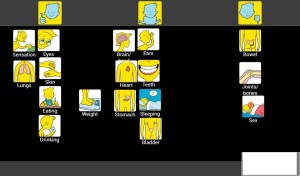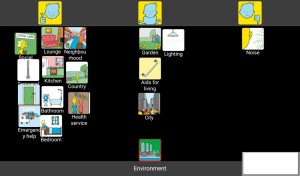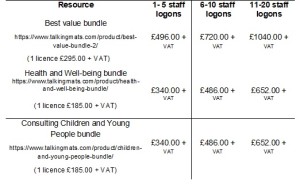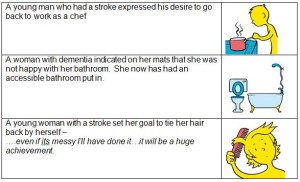We are delighted to introduce Rachel Woolcomb our first Talking Mats OT Associate. She is joining the Talking Mats Team and will be working to develop awareness and use of Talking Mats by Occupational Therapists. I will let Rachel introduce herself:
I am delighted that Talking Mats have asked me to join their team for one day a week. I am passionate about occupational therapy and about Talking Mats and to have the opportunity to bring these two loves together and seeing what develops is very exciting.
I live in South Gloucestershire and have had a varied career since I qualified as an Occupational Therapist in 1992. I was introduced to Talking Mats in 2008 and have never looked back, using them with my clients ever since.
In 2017, having spent over 25 years working in the NHS, I made the decision to move into independent practice. I work predominately with teenagers and adults who live with long term neurological conditions or who have experienced catastrophic injuries following trauma. I am very aware of the psychological impact of sudden disability and the need for people to be able to express who they are and what is important to them, even in difficult circumstances.
I now use Talking Mats with most of my clients. It doesn’t matter if they are old or young, can speak or have communication needs, they all benefit from the opportunity to stop and think and have someone really listen to them.
In the last few weeks a man who has had a stroke and has limited expressive speech has used a Talking Mat to talk about what leisure activities he used to enjoy. He then used a second mat to explain what he can and cannot achieve now. This helped us together, set goals for occupational therapy. I am also working with a teenager who has had a traumatic brain injury and now struggles with her education. She uses Talking Mats with me regularly, to think about her coping skills at school. Looking back at her previous mats is helping her to recognise progress. I have so many more examples and will be sharing them with you soon!
I really want to inspire OT’s, helping them to consider how they enable their clients to think, communicate their choices and make decisions. A Talking Mat is a great for this. It is also creative and interactive something that in my experience OT’s like! I will also be looking at important issues within the field of occupational therapy that are currently driving practice, such as personalised care, goal setting and shared decision making. I believe it is vitally important that we collaborate with our clients as together we can achieve so much more. Talking Mats is an effective tool in enabling this, so watch this space, and please do get in touch if you want to know more or have stories to share.
It is great to have Rachel working with us to build on some of the excellent work being done already in the Occupational Therapy Sector. Our Director, Lois Cameron shares why we are so excited to welcome Rachel to our Team:
‘I am really pleased that Rachel is joining us . I think the Talking Mats approach sits well with the values and approach of Occupational therapy, In my experience OTs are naturally holistic in their approach. I remember at a training course in London an OT said for her Talking Mats was the missing link in her toolkit. The training and experience of OTs allow them to see things through a different lens and that will be really helpful to us’
For more information about how OT and Talking Mats are a winning combination, take a look at Rachel’s recent blog – https://www.talkingmats.com/talking-mats-and-ot-a-winning-combination/
Feeling inspired and want to know more about the training courses we offer? See www.talkingmats.com/training/ for details.
Thanks so much to all the practitioners who have sent us guest blogs about using Talking Mat in a Criminal Justice setting. Here are our top 5 – in no particular order!
1. Supporting Families in the Criminal Justice System: Sally Kedge, Speech and Language Therapist from Trouble Talking New Zealand shares two powerful case examples of using Talking Mats with children and families caught up in the criminal justice system. https://www.talkingmats.com/support-for-prisoners-families-experience-from-new-zealand/
2. Communication Needs within Youth Justice – Part 1: On 17th April 2017, we organised a seminar to look at underlying issues and share good practice when addressing the communication needs of people in youth justice. We had representatives from: the Scottish government, the NHS; Third sector organisations working in youth justice, the police, social workers, professional bodies, universities and social work – from as far afield as New Zealand. The emphasis from the start was that understanding communication is key to improving service delivery. https://www.talkingmats.com/communication-needs-in-youth-justice/
3. Communication Needs within Youth Justice – Part 2: The afternoon session of our seminar on 17.04.17 continued the underlying theme that communication support needs are often hidden and many looked after children have support needs that remain unidentified. The outcome of the day was the establishment of a collaborative network. https://www.talkingmats.com/youth-justice-and-communication-needs-2/
4. Setting up a SLT Service in Prison: This inspiring blog by Jacqui Learoyd explores her role in setting up a speech and language therapy ( SLT ) service in a prison and her use of Talking Mats in that setting https://www.talkingmats.com/setting-up-an-slt-service-in-prison/
5. Has Talking Mats been used in Court? Two registered intermediaries talk about a couple of cases where Talking Mats was used as part of the achieving best evidence (ABE) interviews. https://www.talkingmats.com/talking-mats-used-court/
If you have been inspired and are not yet trained, come along to one of our Foundation training courses – for details see https://www.talkingmats.com/training/foundation-training/
We also offer online training if you are unable to access the training locations – for details see https://www.talkingmats.com/training/online-training/
Improving communication with board games
Thanks to Karen MacKay from Focus Games for this new guest blog.
Playing board games can deliver more benefits than just having fun with friends and family. In the workplace they help people to learn, collaborate and communicate, while they are having fun:
1. Breaking the ice
Ever attended an event or meeting where you didn’t know anyone? A board game helps everyone to become involved, talking and interacting, with each other – who doesn’t feel more comfortable, relaxed and happy to chat after playing a game together?
2. Learning through play
We learn through play when we are children, and it works just as well for adults too. Educational board games are a great way to learn from others, share experiences, ideas and gather new knowledge from the game itself. Plus you’ll be having fun – what’s not to love?
- Developing social skills
Playing board games helps children learn to share, take turns, be a gracious loser and, for shyer children, to come out of their shell more. As adults, we continue to refine our social skills through games. They promote collaboration, communication, and teamwork, useful skills for us all!
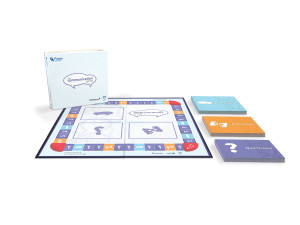
For many people who have communication support needs, accessing health and social care and other public services is a challenge. We partnered with Talking Mats who worked with us and a group of people with communication support needs to develop and test The Communication Game. Initial development was funded by NHS Education For Scotland, and The Communication Game was born as an engaging way to help us all to reflect and develop our own and our teams communication, and thus improve the quality and safety of services.
The Communication Game is designed to help anyone working in health and social care to improve how they communicate, particularly with people who have communication support needs. Playing the game will help you think about the barriers to effective communication; and things you can do to ensure you communicate well with others. It is being used by many groups across the country including allied health professionals, nurses, charities, voluntary and community groups, nursing/care home staff and students studying nursing, speech and language therapy, social care and more.
The Communication Game uses questions to help build knowledge, scenarios to help you see the issues people face when communicating, and activities to help you practise different ways of communicating. It is a 1-hour training session for up to 10 people that you can use over, and over again with different groups.
The game is available from Focus Games and you can learn more and order at www.communicationgame.co.uk
In Stockport we have a termly ‘Voice of the Child/Young Person’ Champions Network meeting during which professionals working in health, education and social care settings across the area meet to discuss real-life examples and to share information and strategies – during the last meeting in October 2018, we discussed using Talking Mats to support police interviewing.
Louise Tickle, Specialist Learning Disability Nurse from the Children’s Learning Disability Team at Stockport NHS Foundation Trust, shared a great example of using Talking Mats to support a child she was working with to share information about a serious safeguarding concern. Louise had been asked by the police to carry out a Talking Mats session with the child as they were aware that she was already using this approach. Louise led the session and was supported by the child’s school SENCO, who had also been Talking Mats trained. The aim was to explore a disclosure which the child had previously made.
Louise shared some great tips about using Talking Mats during an investigation phase:
- Introduce the Talking Mat with a familiar topic, then move on to the main topic/ area of concern
- Watch out for non-verbal cues – initially, the child appeared to be happy and relaxed during the interview, however the child’s non-verbal communication visibly changed when the topic changed. It is easier to pick up on these non-verbal cues if you are able to video the session.
- Have another Talking Mats trained observer present if possible to support and evaluate the session with you.
- Make sure you use terminology that the child is familiar with, and use language that the child would use themselves e.g. when describing body parts.
Talking Mats are often used by people working within the justice system, including registered intermediaries – here is the link to one of our previous blog posts for more information: https://www.talkingmats.com/talking-mats-used-court/.
In this work you must be clear about the different stages of safeguarding and follow the procedures within your organisation. Disclosure and investigation are two different phases. The Keeping Safe resource has been trialled and tested to support people to raise concerns. https://www.talkingmats.com/keeping-safe-a-new-talking-mats-resource-available-to-purchase/ . When a disclosure moves to the investigation phase you may have to personalize the mat to fit the situation but what is key is that you keep the options open and non-leading.
For further information about accessing one of our Talking Mats Foundation Training Courses across the UK, and our ‘Keeping Safe’ Advanced course, see our training options here https://www.talkingmats.com/training/
This blog by Jacqui Learoyd explores her role in setting up a speech and language therapy ( SLT ) service in a prison and her use of Talking Mats in that setting . HMP Berwyn is a large prison which opened in February 2017. To help you understand the challenges facing me when setting up this service in a new prison, I’ll tell you something about prisons, the people in prison, and the healthcare provision at HMP Berwyn.
In the UK the prison population is just growing and growing. The graphic above is taken from the Commons Library Briefing of April 2017 so that you can see the trend. The number of people in the prison system as of April 2018 is 83,617. The reoffending rate is about 30%.
From this data alone, we can see that something needs to change in order to reduce offending and re-offending. Part of the ‘something which needs to change’ is considering offender rehabilitation / prison reform. This led to the building of the UK’s newest prison – HMP Berwyn.
We tend to shorten the name of the prison to just ‘Berwyn’, so that is what I will call it in this short piece. Berwyn has a focus on rehabilitation and treating people as individuals. We aim for the provision of high quality healthcare. We have space for 2106 gentleman – which makes us quite a large facility. We also give attention to the words which we use in our daily conversations – the clients are not called prisoners, but ‘men’, the cells are ‘rooms’, people are called by their first names, etc.
The healthcare provision is an integrated multidisciplinary team with a mix of professionals offering a range of skills. It’s called the Health and Wellbeing Team as it offers holistic care to our clients. I’m happy to say that this includes full time Speech and Language Therapy (SLT), which is where I come in.
Speech and Language Therapy is necessary in a prison setting as a significant proportion of people in the criminal justice system will have speech, language and communication needs. Some research suggests that this may be as high as 91% (Brooks, 2011). Many of these people will not have accessed SLT in the past, and will have developed their own strategies in hiding their difficulties. This is why communication impairment is a hidden disability in this client group. Alongside this, people in prison experience much worse mental and physical health compared with the general population. There are more head injuries, more illnesses caused by drugs and alcohol, higher numbers of people with diagnosed mental illness and more people with conditions such as ADHD. The prison population is aging, so we have all the illness which link with an aging population too, such as strokes, dementia, cancers. You can see that as a service, we are going to be kept very busy!
We’ve got lots of plans for how to tackle some of the things which we want to do as an SLT service, but something which we have already achieved is using Talking Mats.
My first thought was how the men at Berwyn would respond to a conversation using a set of symbols and a doormat. Needless to say, they took it to without question – even the toughest looking customers who had been ‘inside’ for many years happily sat down with me to chat using the tool. Not only did they tolerate the Talking Mat, but they loved it – reporting that they were able to organise their thoughts and report their views more easily.
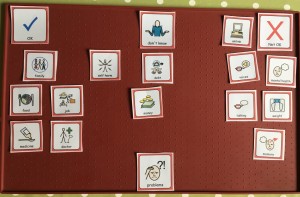
Some clients wanted to say more about emotions following completing the ‘problems’ Talking Mat. We used a ‘me’/’not me’ visual scale and symbols to represent emotions. This Talking Mat requires the client to have some emotional awareness skills so that they can recognise what they are feeling. Not all of the clients are at this stage, and it is especially hard for depressed people to access their emotions vocabulary (Bryan,2013).
Here is an example of this Talking Mat. This information could be used as a starting point to develop an emotions safety plan with an individual. After completing this Talking Mat with a 21 year old man who has a significant history of Adverse Childhood Events, he wanted to make his own Talking Mat about his life experiences. This is a young man who finds expressing his emotions and past very difficult. I was quietly excited that he was prepared to share more information. We have sat together and used the symbol software to make his symbols, and next week I will get to see what he is going to tell me.
And lastly, we have met some clients who have a diagnosis of an Autistic Spectrum Condition. They had attracted this diagnosis during their teen or adult years, but had limited understanding of what Autism is or how it affects them on a personal basis. Being in prison, they can’t Google to find out more as you and I might.
We have developed a Talking Mat which explores ‘what is Autism?’ and allows the client to learn while they report on what having autism feels like for them. We hope to develop the responses on this Talking Mat into a person centred communication passport which can be shared to help all their communication partners.
We keep thinking about ‘what next?’ with the clients and the SLT service, and we continue to develop symbol sets for more Talking Mats conversations. Often we are being led by the clients in terms of what they need in Talking Mat form.
We have strong links in the wider team, so will be doing more Talking Mats work with psychology, substance misuse and nursing colleagues. We hope to access the Talking Mats Accredited Training and expand the number of people using Talking Mats to include Offender Managers and Prison Officers. Alongside this we are developing healthcare pathways for clinical work such as end of life care, so will be applying the Talking Mats methodology to advanced care planning. There’s a lot to do!
Postscript
If any of you want you to link with Jacqui to discuss this further please let us know and we will link you with her. If you want to become confident and skilled at using Talking Mats then please come on a training We also have an online course
References
Brooks, V., 2011. Report outlining the findings of a 13 month pilot project examining the effectiveness of speech and language therapy for young people known to Exeter, East and Mid Devon Youth Offending Team. East and Mid Devon Youth Offending Team.
Bryan, K. (2013). Psychiatric disorders and communication. In L. Cummings (Ed.), The Cambridge Handbook of Communication Disorders (Cambridge Handbooks in Language and Linguistics). Cambridge: Cambridge University Press. doi:10.1017/CBO9781139108683.020
Grateful thanks to Prof. Dr. Norina Lauer, OTH Regensburg – University of Applied Sciences, Germany for this blog.
At the conference of the German Society for Aphasia Research and Treatment (GAB) from the 1st to the 3rd of November Franziska Rau presented a poster – Let pictures talk – about her bachelor thesis on Talking Mats.
Speech and language therapists from German-speaking countries meet at this conference to present their latest research findings. This year’s theme was ” Aphasia Therapy Digital”.
The presented bachelor thesis about Talking Mats was performed at the HAN University of Applied Sciences, Netherlands, and was written by Franziska Rau together with Karoline Bitter and Lara Stobrawe. The students asked 29 people with aphasia and 63 people without aphasia for how representative they rated the images and terms used in the Communication section of the Digital Talking Mats Health & Well-being resource. While the healthy persons judged many items as not clear enough, the people with aphasia estimated significantly more pictures and names as appropriate. For this purpose, various reasons have been discussed, such as the possibility that the persons with aphasia directly perceived the pictures and terms as aids, while healthy persons judged more critically on the basis of the task. But also problems of concentration or comprehension in people with aphasia would be causally conceivable. This should be examined in further studies.
The poster was presented as part of a poster session and was well received by the audience. Thanks to Franziska, Karoline and Lara for their great study and to Holger Grötzbach, Janine Coopmans and Xaver Koch who supported the students.
We are always happy to receive projects and posters from anyone studying how Talking Mats can be used
Talking Mats received funding from The Health and Social Care Alliance Scotland to look at how using the Digital Talking Mats can help people with long term conditions, including dementia, to manage their health and well-being and to recognise their own strengths and abilities. We also hoped that participants would be able to have more control over their lives and have improved communication with families and professionals.
11 people living with dementia and their partners were involved in the project. Each participant had a tablet device and was given a personal digital Talking Mats licence which gave them access to 13 topics in the Talking Mats Health and Well-being resource. We visited each participant at home, taught them how to use it and asked them to complete at least 1 digital Talking Mat per week for 6 weeks on any topic they wished. The design of the digital Talking Mat allowed them to email their mats directly to us. We visited each participant a second time to discuss how easy it was to use the digital Talking Mats and their views on their completed mats. We asked those who wished to, to continue sending us completed mats beyond the initial 6 weeks and we visited them again in 6 months to discuss how they were managing.
In total we received 94 digital mats across all 13 topics from the participants living with dementia who reported that the use of the Digital Talking Mats during this project gave them a better understanding of their own individual health and social care needs.
A woman with dementia said ‘It (Health mat ) made me realise things are not so bad and made me think I will continue with my exercise classes, carry on walking, socialising and eating well’
As well as helping participants self-manage their lives, an unexpected outcome of this project was that many people found that using the Digital Talking Mats helped them see the positive things in their life and not just the negative. It also highlighted that despite having a deteriorating illness, things were not getting worse.
‘This mat (Environment) showed me how happy I am in my own home and my neighbourhood’
The following are some of the comments we received throughout the project.
• It helps me sort out my thoughts – very useful
• I get so much out of the process
• I come up with insights which might help me in the future
• I can now talk to (my wife) in a way I couldn’t before
• I’m more relaxed now
• I come up with niggly health things that my partner didn’t know
‘It made me realise things are not so bad’.
If you know of anyone living with dementia would like to obtain the Digital Talking Mats please fill in the attached Personal Digital Licence 161117 DTM personal licence form with explanation and send it to us at info@talkingmats.com
The Talking Mats digital app is available for organisations to purchase. This is an efficient way to support staff to evidence person centred planning.
The digital app typically operates via individual logons which means personal data is kept securely and it complies with data protection and client confidentiality. The individual with the logon can use their Digital Talking Mat with as many client/patients as they want.
We recognise that organisations may want to purchase several logons for staff to access digital Talking Mats and for that reason have created an Organisational Talking Mats digital licence. The savings are significant.
For application criteria please contact the Talking Mats office on 01786 479511
Self-management for people with long term conditions (LTC) is now a key government strategy to encourage people to take responsibility for their own health, behaviour and well-being. Talking Mats received funding from The Health and Social Care Alliance Scotland to look how using the Digital Talking Mats (DTM) can help people with LTCs to manage their health and well-being and to recognise their own strengths and abilities.
The overall aim of our project was to empower people with different long term conditions, to manage their own health and well-being. Through using Digital Talking Mats (DTM) we hoped that participants would be able to have more control over their lives and have improved communication with families and professionals.
There were a total of 28 participants in this project living with one of three different long term health conditions – stroke, dementia and learning disability. Each participant had access to a tablet device and was given a personal DTM licence which gave them access to 13 topics in the Talking Mats Health and Well-being resource. We visited each participant at home and taught them how to use it and asked them to complete and send us at least 1 digital mat per week for 6 weeks on any topic they wished. The design of the digital Talking Mat allowed them to email their mats directly to the researchers. We visited each participant a second time to discuss on how easy it was to use the digital Talking Mats and their views on their completed mats. We asked those who wished to, to continue sending us completed mats beyond the initial 6 weeks. We visited them again in 6 months to discuss how they were managing.
15 participants completed all 6 mats and 12 participants continued to complete mats over the length of the project. Participants completed 235 digital mats across all 13 topics
There were 3 particularly significant findings
1. At 18 months the participants living with dementia actually felt their well-being had improved, despite dementia being a progressive illness.
2. For the participants living with stroke the results were even more striking as 95% felt things were going well at the end of the project in comparison with 47% at the beginning.
3. At the end of the project the percentage of people with learning disability who felt things were not going well had reduced from 19% to 10%. Furthermore the percentage of people indicating that they were not sure about their views had increased from 27% to 42%. There can be a tendency for people with learning disability when using Talking Mats, to express their views at either end of the mat and to rarely use the mid- point. However being able to use the unsure mid- point is noteworthy as it indicates that the participants in the project realised that they could express their views not only as black or white but could indicate that they were unsure. This awareness opens up the potential for people to express views more thoughtfully with opportunities for further exploration.
Here are three examples of how using the DTM supported people to self-manage situations in their lives. Click on image to enlarge.
As well as helping participants self-manage their long term conditions, an unexpected outcome of this project is that many people found that using the DTM helped them see the positive things in their life and not just the negative. It also highlighted that despite having a long term condition and, for many also a deteriorating one, that things were not getting worse.
Click here for full report including 6,12 and 18 month reports to the funders 20180717 Alliance full report
Click here for the summary report 20180717 Alliance Final Short Report
Click here for a video link of 2 participants
One of the reasons why Talking Mats works is because it reduces the demand on the ‘thinker’ to remember the question, find the vocabulary needed to answer, construct the answer into a sentence, and then say it clearly. This reduced demand allows more ‘thinking time’.
Here’s a link to our website with more reasons why Talking Mats works
https://www.talkingmats.com/about-talking-mats/#whyitworks
Another reason people respond well to it is there is no right or wrong answer. It is not a test.
Sometimes the listener can forget their role and use the interaction as a test or as a language exercise. E.g . ‘Do you know what this picture is? ‘What’s this one called?’ This makes the demands on the thinker instantly increase as they are required to formulate an answer. Checking the persons level of understanding first may be necessary but it shouldn’t be done as part of the Talking Mat.
In our training we recommend avoiding ‘why’ questions , as they can make a person feel they have made an error. If the listener wants to know more, then a sub mat can be done
Our mission statement is to maximise the person’s capacity to express what they think. Let’s help them to do that!
 Online training login
Online training login 




